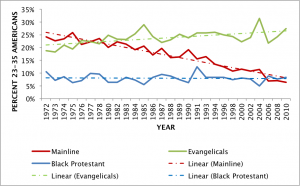 The graph at right illustrates the shifts in young adult (ages 23-35) Protestant affiliation between 1972 and 2010 as compiled by Lifeway Research using data from the General Social Survey. Overall, during the “last 30 years, mainline protestantism is dying, black protestantism is steady, and evangelicalism is growing.” More specifically, among young adults:
The graph at right illustrates the shifts in young adult (ages 23-35) Protestant affiliation between 1972 and 2010 as compiled by Lifeway Research using data from the General Social Survey. Overall, during the “last 30 years, mainline protestantism is dying, black protestantism is steady, and evangelicalism is growing.” More specifically, among young adults:
- Mainline Protestantism declined dramatically: identification dropped from 24% to 6% while worship attendance was cut in half moving from 4% to less than 2%
- Black Protestantism was stable: identification around 10% with worship attendance around 2%
- Evangelical Protestantism increased somewhat: identification rose from 21% to 25% while weekly attendance rose from 7.5% to 9%
So What?
When it comes to young adults (ages 23-35), the trend is clearly away from the mainline and toward religious non-identification (the nones) and evangelicalism. As one who has spent most of my life in the mainline and who, at least for a bit longer, meets the guidelines for being considered a young adult I am troubled by the overall decline in mainline identification, but especially concerned by the even more significant decline among young adults.
- Is your congregational leadership aware of these statistics regarding young adults? If so, how have they factored in to long range planning and specific strategic initiatives? If not, how will you work to ensure that the appropriate leadership bodies see and discuss the data?
- Why do you think mainline identification has declined more dramatically among young adults than the population as a whole? Given that similar shifts have not occurred in other Protestant groups, what types of change may be required to reverse this trend?